Native legends of Little people and mythological creatures
Part 3
cos·mog·o·ny
noun \käz-ˈmä-gə-nē\
plural cos·mog·o·nies
Definition of COSMOGONY
1 : a theory of the origin of the universe
2 : the creation or origin of the world or universe
***************************************
They also prayed for good crops and celebrated the seasons based on the time and phase of the moon as well as natural occurrences here on Earth. As you read you might see similarities between the Iroquois beliefs and traditions and those of where you live.
How the Iroquois Give Thanks
The Iroquois Red Children are a grateful people. The true Iroquois never rises after eating without saying, “Niaweh,” which means, “I am thankful.” The others reply, “Niuh,” - “It is well.”
The Red Children never pick a flower without thinking how kind the Great Spirit has been, to cause the flowers to grow. They like flowers, and no matter how poor the Indian's cabin, flowers are always to be found nearby.
When the Iroquois pick fruit they give thanks to the Great Spirit. And always do they leave some, for the “little brothers of the wood.”
They do not try to pick every cherry, or berry, or nut or apple for themselves. Fruits grow for the birds and animals as well as for men, and the little brothers of the wood must not be forgotten. Some of everything that grows is left for them.
During the spring and summer, the Iroquois give several thanksgiving feasts. The first is in the early spring, at maple sugar time. As soon as the sap begins to flow, the Maple Feast is called.
The Indians gather about a large maple tree. A fire is lighted nearby, upon which one of their number sprinkles tobacco. As the smoke rises, a prayer of thanksgiving is made to the Great Spirit, for causing the sweet waters of the maple to flow. Then the maple trees are thanked for their service to men, and protection is asked for the trees during the coming year.
When “the leaf of the dogwood is the size of a squirrel's ear,” it is planting time. Then an Indian maid goes into the fields and scatters a few grains of corn, asking the aid of the Great Spirit for the harvest. The Indian always plants his seeds with the growing moon, that it may grow with the moon.
The next feast is the Strawberry Feast and Dance.
When the strawberry ripens, the Red Children are happy. They sing their praises to the Great Spirit and dance with joy. They remember the Little People who have helped to make the berries beautiful, and they have a song of praise and a dance of thanks for them as well. Without the help of the Little People, the strawberries would not be so sweet and ripe.
At the time of the Harvest Moon comes the last feast of the summer. This thanksgiving lasts for sour days. The Indians not only give thanks for the ripening of the corn, but for every growing thing. Therefore, this feast is longer than the others, since it takes some time to name all of the good gifts of the Great Spirit to the Red Children, and to give thanks for them all.
The following is borrowed from another book, Myths and Legends of the Iroquois, by Harriet Maxwell Converse:
The following is borrowed from another book, Myths and Legends of the Iroquois, by Harriet Maxwell Converse:
The spirit of the corn is a maiden, and not a handsome young chief, as one of the stories claims. The Corn Maiden was one of three sisters, and was called Ona tah.
The three sister vegetables – the corn, the bean, and the squash – were called the Di o he ko, which means “those we live on,” since they are the life-giving vegetables.
These sisters lived together on a hill and were quite happy there. But one day Ona tah wandered away in search of dews for her kernels.
The Evil Spirit was watching. He seized Ona tah, the Spirit of the Corn, and sent one of his monsters to blight her fields. The killing winds swept over the hill, and the spirits of the squash and the bean fled before them.
Ona tah was held for some time a prisoner in the darkness under the earth, by the Evil Spirit.
At last a sun ray found her and guided her back to her lost hilltop. There she found her sisters had fled. She was alone.
At last a sun ray found her and guided her back to her lost hilltop. There she found her sisters had fled. She was alone.
Then Ona tah made a vow that she would never again leave her fields. But she sighs for her lost sisters, and mourns the blight that came upon her beautiful fields. For since the time when Ona tah wandered away from her fields, the corn has not grown so tall or so beautiful as it once did.
With love form your Fairy Lady











No comments:
Post a Comment